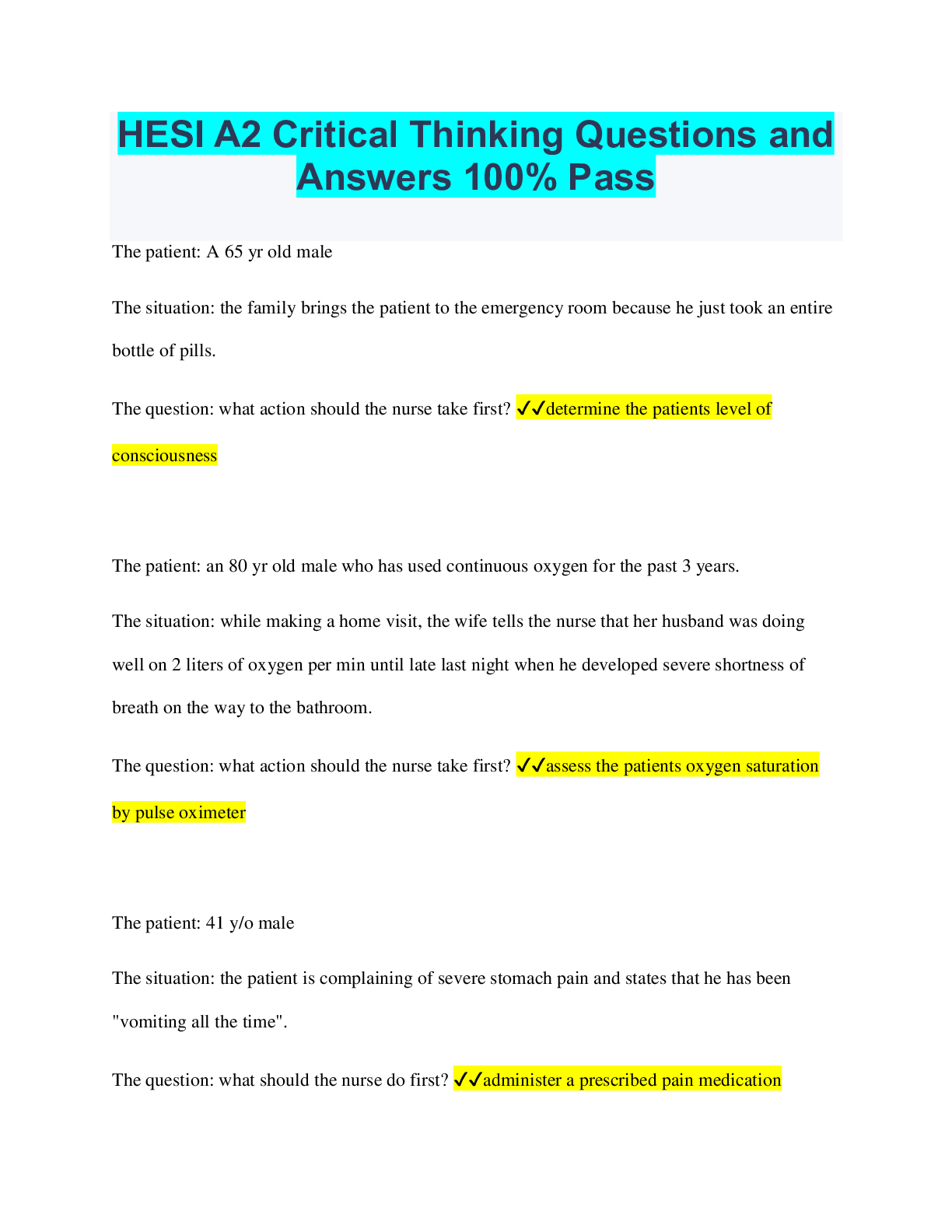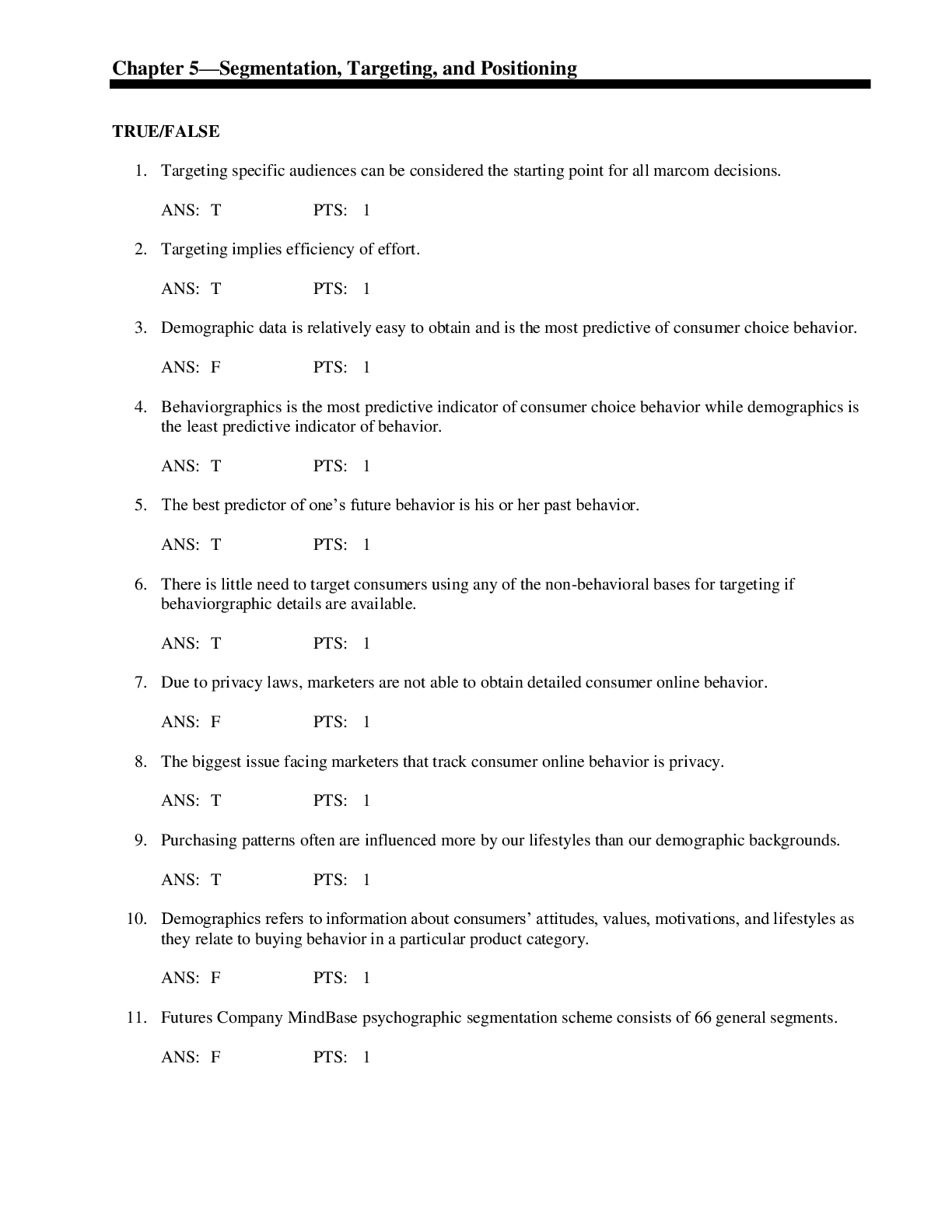*NURSING > QUESTIONS & ANSWERS > NCLEX-PN Review Questions and Answers Latest 2022 Already Passed (All)
NCLEX-PN Review Questions and Answers Latest 2022 Already Passed
Document Content and Description Below
NCLEX-PN Review Questions and Answers Latest 2022 Already Passed The nurse is taking the health history of a patient being treated for Emphysema and Chronic Bronchitis. After being told the patient... has been smoking cigarettes for 30 years, the nurse expects to note which assessment finding? 1. Increase in Forced Vital Capacity (FVC) 2. A narrowed chest cavity 3. Clubbed fingers 4. An increased risk of cardiac failure ✔✔3. Clubbed fingers - CORRECT Clubbed fingers are a sign of a long-term, or chronic, decrease in oxygen levels. The nurse is taking the health history of a 70-year-old patient being treated for a Duodenal Ulcer. After being told the patient is complaining of epigastric pain, the nurse expects to note which assessment finding? 1. Melena 2. Nausea 3. Hernia 4. Hyperthermia ✔✔1. Melena - CORRECT Melena is the finding that there are traces of blood in the stool which presents as black, tarry feces. This is a common manifestation of Duodenal Ulcers, since the Duodenum is further down the gastric anatomy. A nurse is providing discharge teaching for a patient with severe Gastroesophogeal Reflux Disease. Which of these statements by the patient indicates a need for more teaching? 1. "I'm going to limit my meals to 2-3 per day to reduce acid secretion." 2. "I'm going to make sure to remain upright after meals and elevate my head when I sleep" 3. "I won't be drinking tea or coffee or eating chocolate any more." 4. "I'm going to start trying to lose some weight." ✔✔1. "I'm going to limit my meals to 2-3 per day to reduce acid secretion." CORRECT - Large meals increase the volume and pressure in the stomach and delay gastric emptying. It's recommended instead to eat 4-6 small meals a day. The nurse in the Emergency Room is treating a patient suspected to have a Peptic Ulcer. On assessing lab results, the nurse finds that the patient's blood pressure is 95/60, pulse is 110 beats per minute, and the patient reports epigastric pain. What is the PRIORITY intervention? 1. Start a large-bore IV in the patient's arm 2. Ask the patient for a stool sample 3. Prepare to insert an NG Tube 4. Administer intramuscular morphine sulphate as ordered ✔✔1. Start a large-bore IV in the patient's arm CORRECT - The nurse should suspect that the patient is haemorrhaging and will need need a fluid replacement therapy, which requires a large bore IV. A female patient with atrial fibrillation has the following lab results: Hemoglobin of 11 g/dl, a platelet count of 150,000, an INR of 2.5, and potassium of 2.7 mEq/L. Which result is critical and should be reported to the physician immediately? 1. Hemoglobin 11 g/dl 2. Platelet of 150,000 3. INR of 2.5 4. Potassium of 2.7 mEq/L ✔✔4. Potassium of 2.7 mEq/L CORRECT - A potassium imbalance for a patient with a history of dysrhythmia can be lifethreatening and can lead to cardiac distress. [Show More]
Last updated: 2 years ago
Preview 1 out of 29 pages
.png)
Buy this document to get the full access instantly
Instant Download Access after purchase
Buy NowInstant download
We Accept:

Also available in bundle (1)
.png)
NCLEX-PN BUNDLED EXAMS QUESTIONS AND ANSWERS LATEST 2022
NCLEX-PN BUNDLED EXAMS QUESTIONS AND ANSWERS LATEST 2022
By Nutmegs 2 years ago
$16
10
Reviews( 0 )
$10.00
Can't find what you want? Try our AI powered Search
Document information
Connected school, study & course
About the document
Uploaded On
Sep 24, 2022
Number of pages
29
Written in
Additional information
This document has been written for:
Uploaded
Sep 24, 2022
Downloads
0
Views
137


























